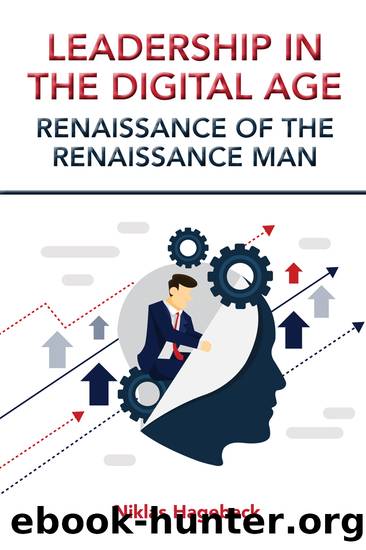Leadership in The Digital Age by Niklas Hageback

Author:Niklas Hageback [Niklas Hageback]
Language: eng
Format: epub
Publisher: Business Expert Press
Published: 2020-10-08T00:00:00+00:00
Formulating an Organizational Blueprint for Innovation
By applying the insights into how innovation happens, how it is best administered, and in what environment it may flourish, a high-level organizational blueprint can be formulated to provide aspiring market leaders, regardless of industry, with inspirational pointers. It should be contrasted with how the creative spirit perishes in a desolate overregulated setting. Recognizing that the chances of recruiting that one-of-a-kind lonely genius that (occasionally) comes up with transformational ideas are slim, corporations should instead seek to establish teams on the basis of collective intelligence with a focus on the less serendipitous types of innovationâexploratory and combinational. With the steps of the creative process identified and ascertained, they provide a sequence on how work on innovation can be structured, pinning out differing roles and responsibilities for each step throughout. Efforts are guided by a holistic leadership. The input parameters will help in forming the building blocks required to produce an abstract representation that constitutes the basis for generating scenarios in the incubation phase. The normal protocol for experimental testing typically includes only variations within the preset assumptions and context. But herein lies a conundrum: the process of creativity with a view to producing new innovative thinking differs from traditional problem-solving given its complexity. It typically lacks a solution that is known in advance, and the problem in itself is usually never exactly defined. Hence, if a solution cannot be found within these narrow parameters, the work risk comes to a standstill. It is in this phase and the ensuing illumination phase that the lonely genius types tend to prove their worth, generating value-adding scenarios that can occasionally materialize as a viable solution, often falling far outside the existing scientific or commercial doctrine, which makes it so hard for the average expert to replicate. Historical hindsight shows it is in that realm that scientific breakthroughs often occur. From the cognitive perspective, it is an iterative process that arranges the search by narrowing down the key determinants and a potentially correct path often acknowledged by an intuitive subjective feel-good factor, as highlighted by Poincaré. The next step is to start to home in on that particular path in search of a conclusion. So, in complex problem-solving, the incubation phase draws heavily on the seemingly irrational associations that are made in the unconscious part of the mind. This is done with a view to breaking the mental constraints that prevent creative thinking, which is typically limited by the capacity of human imagination and the level of subject matter expertise. In the absence of the lonely genius, a collective intelligence approach may take a multivariate perspective to increase the chances of finding a solution. This can be done by applying imagination to a set problem by distorting some of the objects and relationships as a means of purposely skewing the mental representation to reach a higher representation of reality. At the heart of amalgamating individual human intelligence into a collective intelligence effort lies the ability to produce a suite of conceptual changes, instead of being mentally blocked by a single narrative.
Download
This site does not store any files on its server. We only index and link to content provided by other sites. Please contact the content providers to delete copyright contents if any and email us, we'll remove relevant links or contents immediately.
Time Management Made Easy: How to Cultivate New Habits, Improve Productivity and Get Things Done by Joshua Strachan(2365)
The 7 Habits of Highly Effective People by Stephen R. Covey & Sean Covey(2098)
The Concise Laws of Human Nature by Robert Greene(1715)
Doesn't Hurt to Ask by Trey Gowdy(1555)
Primal Leadership by Daniel Goleman(1125)
Hook Point: How to Stand Out in a 3-Second World by Brendan Kane(1098)
HBR's 10 Must Reads 2021 by unknow(1044)
Don't Sweat the Small Stuff...and It's All Small Stuff by Richard Carlson(1015)
Amazon Unbound by Brad Stone(979)
100 Things Successful People Do by Nigel Cumberland(963)
HBR's 10 Must Reads 2021 by Harvard Business Review(956)
The Job Closer by Steve Dalton(939)
Master of One by Jordan Raynor(934)
Lives of the Stoics by Ryan Holiday & Stephen Hanselman(900)
Declutter Your Mind: A step by step guide to learn to control your thoughts, stop worrying, relieve anxiety and eliminate panic attacks and negative thinking by Mia Chandler(875)
The Power of 100! by Shaun King(844)
Conflicted by Ian Leslie(798)
Coders at Work: Reflections on the craft of programming by Peter Seibel(788)
The Book of Hope by Jane Goodall(744)
